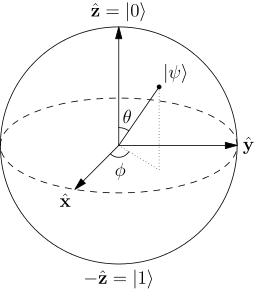Adiabatic quantum computation
Adiabatic quantum computation (AQC) relies on the adiabatic theorem to do calculations[1] and is closely related to, and may be regarded as a subclass of, quantum annealing.[2][3][4][5] First, a complex Hamiltonian is found whose ground state describes the solution to the problem of interest. Next, a system with a simple Hamiltonian is prepared and initialized to the ground state. Finally, the simple Hamiltonian is adiabatically evolved to the complex Hamiltonian. By the adiabatic theorem, the system remains in the ground state, so at the end the state of the system describes the solution to the problem.
AQC is a possible method to get around the problem of energy relaxation. Since the quantum system is in the ground state, interference with the outside world cannot make it move to a lower state. If the energy of the outside world (that is, the "temperature of the bath") is kept lower than the energy gap between the ground state and the next higher energy state, the system has a proportionally lower probability of going to a higher energy state. Thus the system can stay in a single system eigenstate as long as needed.
Universality results in the adiabatic model are tied to quantum complexity and QMA-hard problems. The k-local Hamiltonian is QMA-complete for k ≥ 2.[6] QMA-hardness results are known for physically realistic lattice models of qubits such as [7]
 where
where  represent the Pauli matrices
represent the Pauli matrices  . Such models are used for universal adiabatic quantum computation. The Hamiltonians for the QMA-complete problem can also be restricted to act on a two dimensional grid of qubits[8] or a line of quantum particles with 12 states per particle.[9] and if such models were found to be physically realisable, they too could be used to form the building blocks of a universal adiabatic quantum computer.
. Such models are used for universal adiabatic quantum computation. The Hamiltonians for the QMA-complete problem can also be restricted to act on a two dimensional grid of qubits[8] or a line of quantum particles with 12 states per particle.[9] and if such models were found to be physically realisable, they too could be used to form the building blocks of a universal adiabatic quantum computer.
In practice, there are problems during a computation. As the Hamiltonian is gradually changed, the interesting parts (quantum behaviour as opposed to classical) occur when multiple qubits are close to a tipping point. It is exactly at this point when the ground state (one set of qubit orientations) gets very close to a first energy state (a different arrangement of orientations). Adding a slight amount of energy (from the external bath, or as a result of slowly changing the Hamiltonian) could take the system out of the ground state, and ruin the calculation. Trying to perform the calculation more quickly increases the external energy; scaling the number of qubits makes the energy gap at the tipping points smaller.
D-Wave quantum processors
The D-Wave One is a device made by a Canadian company D-Wave Systems which describes it as doing quantum annealing.[10] In 2011, Lockheed-Martin purchased one for about US$10 million; in May 2013, Google purchased a D-Wave Two with 512 qubits.[11] As of now, the question of whether the D-Wave processors offer a speedup over a classical processor is still unanswered. Tests performed by researchers at USC, ETH Zurich, and Google show that as of now, there is no evidence of a quantum advantage.[12][13]
Notes
- ↑ Farhi, E.; Goldstone, J.; Gutmann, S.; Sipser, M. (2000). "Quantum Computation by Adiabatic Evolution". v1. arXiv:quant-ph/0001106. Unsupported parameter(s) in cite arXiv (help)
- ↑ Kadowaki, T.; Nishimori, H. (1998-11-01). "Quantum annealing in the transverse Ising model". Physical Review E 58: 5355. doi:10.1103/PhysRevE.58.5355.
- ↑ Finilla, A.B.; Gomez, M.A.; Sebenik, C.; Doll, D.J. (1994-03-18). "Quantum annealing: A new method for minimizing multidimensional functions". Chemical Physics Letters 219 (5): 343–348. doi:10.1016/0009-2614(94)00117-0.
- ↑ Santoro, G.E.; Tosatti, E. (2006-09-08). "Optimization using quantum mechanics: quantum annealing through adiabatic evolution". Journal of Physics A 39 (36): R393. doi:10.1088/0305-4470/39/36/R01.
- ↑ Das, A.; Chakrabarti, B.K. (2008-09-05). "Colloquium: Quantum annealing and analog quantum computation". Reviews of Modern Physics 80: 1061. doi:10.1103/RevModPhys.80.1061.
- ↑ Kempe, J.; Kitaev, A.; Regev, O. (2006-07-27). "The Complexity of the Local Hamiltonian Problem". SIAM Journal on Computing (Philadelphia: Society for Industrial and Applied Mathematics) 35 (5): 1070–1097. arXiv:quant-ph/0406180v2. doi:10.1137/S0097539704445226. ISSN 1095-7111.
- ↑ Biamonte, J.D.; Love, P.J. (2008-07-28). "Realizable Hamiltonians for Universal Adiabatic Quantum Computers". Physical Review A (Physical Review) 78 (1): 012352. arXiv:0704.1287. Bibcode:2008PhRvA..78a2352B. doi:10.1103/PhysRevA.78.012352.
- ↑ Oliveira, R.; Terhal, B.M. (2008-11-01). "The complexity of quantum spin systems on a two-dimensional square lattice". Quantum Information & Computation 8 (10): 0900–0924. arXiv:quant-ph/0504050.
- ↑ Aharonov, D.; Gottesman, D.; Irani, S.; Kempe, J. (2009-04-01). "The Power of Quantum Systems on a Line". Communications in Mathematical Physics 287 (1): 41–65. arXiv:0705.4077. Bibcode:2009CMaPh.287...41A. doi:10.1007/s00220-008-0710-3.
- ↑ "Quantum Computing: How D-Wave Systems Work". D-Wave. D-Wave Systems, Inc. Archived from the original on 2014-09-14. Retrieved 2014-08-28.
- ↑ Jones, Nicola (2013-06-20). "Computing: The quantum company". Nature (Nature Publishing Group) 498: 286–288. doi:10.1038/498286a. Archived from the original on 2014-01-03. Retrieved 2014-01-02.
- ↑ Boixo, S.; Rønnow, T.F.; Isakov, S.V.; Wang, Z.; Wecker, D.; Lidar, D.A.; Martinis, J.M.; Troyer, M. (2014-02-28). "Evidence for quantum annealing with more than one hundred qubits". Nature Physics 10: 218–224. arXiv:1304.4595. doi:10.1038/nphys2900.
- ↑ Ronnow, T.F.; Wang, Z.; Job, J.; Boixo, S.; Isakov, S.V.; Wecker, D.; Martinis, J.M.; Lidar, D.A.; Troyer, M. (2014-01-13). "Defining and detecting quantum speedup". arXiv:1401.2910.
| ||||||||||||||||||||||||||||||||||||||||||||||
